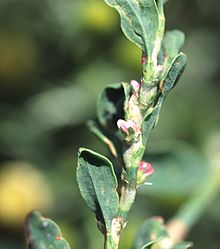Polygonum arenastrum
| Polygonum arenastrum | |
|---|---|
 |
|
| Scientific classification | |
| Kingdom: | Plantae |
| (unranked): | Angiosperms |
| (unranked): | Eudicots |
| (unranked): | Core eudicots |
| Order: | Caryophyllales |
| Family: | Polygonaceae |
| Genus: | Polygonum |
| Species: | P. arenastrum |
| Binomial name | |
|
Polygonum arenastrum Boreau 1857 |
|
| Synonyms | |
|
Synonymy
|
|
Polygonum arenastrum, commonly known as equal-leaved knotgrass,is a summer annual flowering plant in the knotweed family Polygonaceae. It is native to Europe and can be found on other continents as an introduced species and a common noxious weed. Other common names include common knotweed, prostrate knotweed, mat grass, oval-leaf knotweed,stone grass, wiregrass, and door weed, as well as many others, knotweed was first seen in North America in 1809 and is now seen across much of the United States and Canada.
Knotweed develops a deep tap root (it can be as deep as 18”), does well in compacted soil, and survives drought conditions. The numerous wiry stems grow out from the center of the plant giving it a mat-like appearance. The stems are very long and branching and grow in a zigzag form. The leaves are alternate, oblong, hairless, can be ½ to 2 ½ inches long, and are bluish-green in color. The leaf stalk is short and closely surrounded by papery stipules on each node. The stem nodes are slightly swollen and look somewhat like “knots,” thus its common name, knotweed. Flowers, with colors ranging from white to green, are inconspicuous, have no petals, and grow all along the stems. The sepals, however, are pinkish with white edges. Seeds are egg-shaped, dark reddish brown in color, and have a smooth shiny surface.
Some people mistake knotweed for Spotted spurge. An easy way to tell the difference is to break off a stem. Spurges contain milky sap; knotweed does not.
Since common knotweed does well in compacted soils, it is most commonly found in driveways, along roadsides and vacant lots, and in walkways, as well as in turf grass (where there is a lot of footpath wear) and in gardens.
Common knotweed germinates at or near the soil surface in early spring, as soon there is enough moisture, and grows in an upright position before it spreads out like a mat. If mowed, it will still spread and can form a mat as big as 3 to 4 feet in diameter. The seeds, which grow low to the ground, survive mowing and are not disturbed when stepped on by people and animals.
...
Wikipedia
